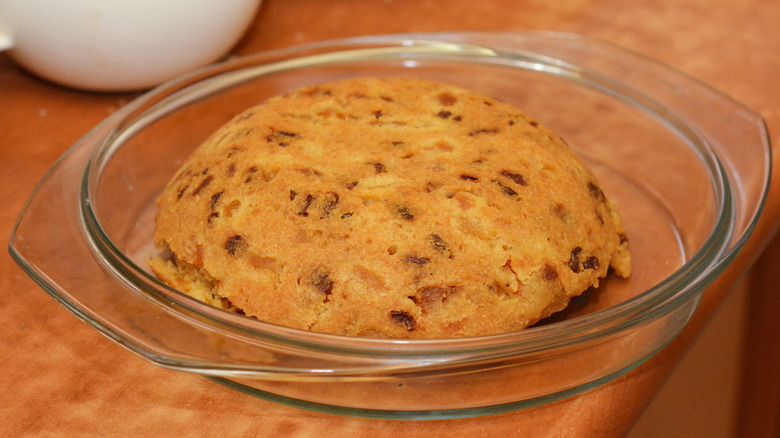Spotted Dick Is The Unfortunately-Named Dessert With British Origins
Some British dishes tend to catch flack for their odd flavor combinations or quirky textures. Take jellied eels, for example, a common dish in London that gets a bad rap. No one can say the land that gifted the world delicacies such as bubble and squeak, a popular side dish with fried potatoes and cabbage, or toad in the hole (sausages baked into Yorkshire pudding) is lacking in name ingenuity. With loads of freshly grown, farm-to-table vegetables, grass-fed livestock, and access to some of the finest cheeses in the world, don't let the silly names fool you. Here's where the unfortunately-named but extremely tasty dessert known as spotted dick pudding comes into the picture.
Spotted dick — hold for laughter — is a steamed pudding typically made with a suet dough, dried fruit, lemon zest, and creamy custard to top it off. For Americans, the word "pudding" usually refers to the iconic creamy custardy dessert. But for Brits, "pudding" is an overarching term that can refer to any sweet or savory dish that's boiled or steamed in something, namely animal casings. Similar to sponge cake, spotted dick is usually served around the holidays, but it was once a mainstay on dessert menus in the U.K. The steamed pudding has a full, rich flavor from the suet with a citrusy tang from the lemon. Texture-wise, it's quite airy combined with a bit of chewiness from the dried fruits, while the vanilla custard adds a much needed injection of moisture and sweetness.
The history of spotted dick and where it stands today
The spongy, steamed pudding is a fairly easy and cheap dish to whip up, with roots that date back centuries. The first recorded recipe of spotted dick pudding was published in a cookbook in the 1840s. The "spotted" component refers to the bits of dried fruit, and well, the word "dick" in 19th-century Britain signified something vastly different than it does today. At various points in time it meant everything from an apron to an abbreviation for "dictionary." But by the mid-1800s, "dick" was being used to describe a pudding. Some argue it is derived from the word "dough," but it's more likely a shorter way to say "puddick," an older term for pudding. When treacle sauce (similar to molasses) was added to these concoctions, it was called "treacle dick," leading to the very first spotted dick.
Although some restaurants have tried to elevate the classic dessert with a rebrand such as the "Spotted Richard," spotted dick isn't as popular on U.K. menus as it once was. If you're down to try this delicacy, you might find it at a traditional British pub, but even better is taking a stab at the simple recipe at home. More recently, puddings have had a resurgence due to the popularity of the BBC series, "The Great British Bake-Off." So, don't knock this funny-named dessert until you try it.

